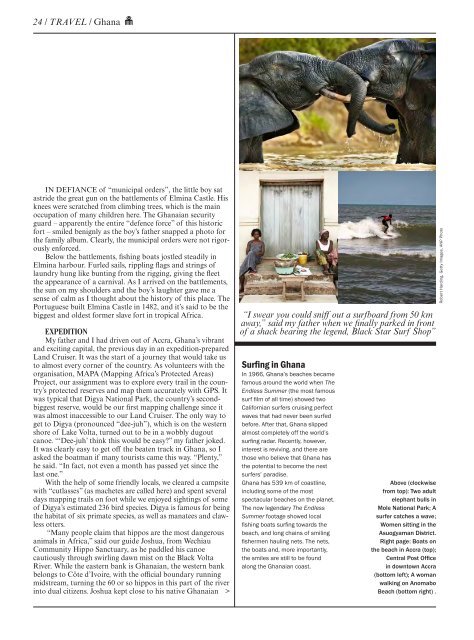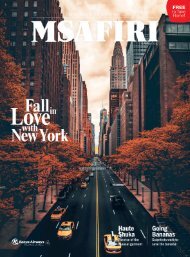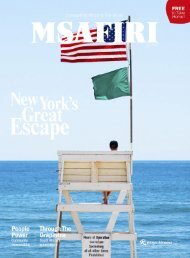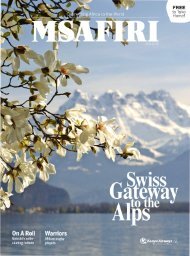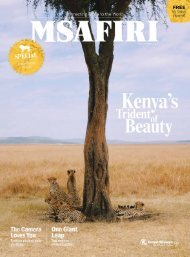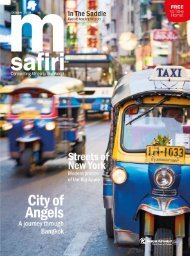Create successful ePaper yourself
Turn your PDF publications into a flip-book with our unique Google optimized e-Paper software.
24 / TRAVEL / Ghana<br />
TRAVEL / 25<br />
IN DEFIANCE of “municipal orders”, the little boy sat<br />
astride the great gun on the battlements of Elmina Castle. His<br />
knees were scratched from climbing trees, which is the main<br />
occupation of many children here. The Ghanaian security<br />
guard – apparently the entire “defence force” of this historic<br />
fort – smiled benignly as the boy’s father snapped a photo for<br />
the family album. Clearly, the municipal orders were not rigorously<br />
enforced.<br />
Below the battlements, fishing boats jostled steadily in<br />
Elmina harbour. Furled sails, rippling flags and strings of<br />
laundry hung like bunting from the rigging, giving the fleet<br />
the appearance of a carnival. As I arrived on the battlements,<br />
the sun on my shoulders and the boy’s laughter gave me a<br />
sense of calm as I thought about the history of this place. The<br />
Portuguese built Elmina Castle in 1482, and it’s said to be the<br />
biggest and oldest former slave fort in tropical Africa.<br />
EXPEDITION<br />
My father and I had driven out of Accra, Ghana’s vibrant<br />
and exciting capital, the previous day in an expedition-prepared<br />
Land Cruiser. It was the start of a journey that would take us<br />
to almost every corner of the country. As volunteers with the<br />
organisation, MAPA (Mapping Africa’s Protected Areas)<br />
Project, our assignment was to explore every trail in the country’s<br />
protected reserves and map them accurately with GPS. It<br />
was typical that Digya National Park, the country’s secondbiggest<br />
reserve, would be our first mapping challenge since it<br />
was almost inaccessible to our Land Cruiser. The only way to<br />
get to Digya (pronounced “dee-juh”), which is on the western<br />
shore of Lake Volta, turned out to be in a wobbly dugout<br />
canoe. “‘Dee-juh’ think this would be easy?” my father joked.<br />
It was clearly easy to get off the beaten track in Ghana, so I<br />
asked the boatman if many tourists came this way. “Plenty,”<br />
he said. “In fact, not even a month has passed yet since the<br />
last one.”<br />
With the help of some friendly locals, we cleared a campsite<br />
with “cutlasses” (as machetes are called here) and spent several<br />
days mapping trails on foot while we enjoyed sightings of some<br />
of Digya’s estimated 236 bird species. Digya is famous for being<br />
the habitat of six primate species, as well as manatees and clawless<br />
otters.<br />
“Many people claim that hippos are the most dangerous<br />
animals in Africa,” said our guide Joshua, from Wechiau<br />
Community Hippo Sanctuary, as he paddled his canoe<br />
cautiously through swirling dawn mist on the Black Volta<br />
River. While the eastern bank is Ghanaian, the western bank<br />
belongs to Côte d’Ivoire, with the official boundary running<br />
midstream, turning the 60 or so hippos in this part of the river<br />
into dual citizens. Joshua kept close to his native Ghanaian ><br />
“I swear you could sniff out a surfboard from 50 km<br />
away,” said my father when we finally parked in front<br />
of a shack bearing the legend, Black Star Surf Shop”<br />
Surfing in Ghana<br />
In 1966, Ghana’s beaches became<br />
famous around the world when The<br />
Endless Summer (the most famous<br />
surf film of all time) showed two<br />
Californian surfers cruising perfect<br />
waves that had never been surfed<br />
before. After that, Ghana slipped<br />
almost completely off the world’s<br />
surfing radar. Recently, however,<br />
interest is reviving, and there are<br />
those who believe that Ghana has<br />
the potential to become the next<br />
surfers’ paradise.<br />
Ghana has 539 km of coastline,<br />
including some of the most<br />
spectacular beaches on the planet.<br />
The now legendary The Endless<br />
Summer footage showed local<br />
fishing boats surfing towards the<br />
beach, and long chains of smiling<br />
fishermen hauling nets. The nets,<br />
the boats and, more importantly,<br />
the smiles are still to be found<br />
along the Ghanaian coast.<br />
Above (clockwise<br />
from top): Two adult<br />
elephant bulls in<br />
Mole National Park; A<br />
surfer catches a wave;<br />
Women sitting in the<br />
Asuogyaman District.<br />
Right page: Boats on<br />
the beach in Accra (top);<br />
Central Post Office<br />
in downtown Accra<br />
(bottom left); A woman<br />
walking on Anomabo<br />
Beach (bottom right) .<br />
Robert Harding, Getty Images, ANP Photo


